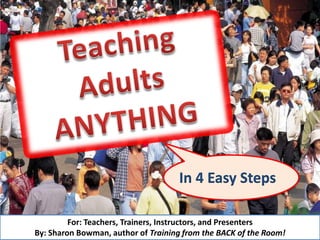Teaching Adults ANYTHING in 4 Easy Steps
- 1. In 4 Easy Steps For: Teachers, Trainers, Instructors, and Presenters By: Sharon Bowman, author of Training from the BACK of the Room!
- 2. a pen and paper because you will be taking some notes.
- 3. *
- 4. * YOU will remember what you WRITE better than what you READ.
- 5. Write one or two facts.
- 6. You just connected to prior learning.
- 7. Write a sentence describing it.
- 8. You just created your personal learning goal.
- 16. How might YOU connect these adult learners to the content and to each other?
- 17. How might YOU connect these adult learners to the content and to each other? Quick-Write Say: ŌĆ£Write a sentence describing what you want to learn and then tell your table group what you wrote.ŌĆØ
- 18. How might YOU connect these adult learners to the content and to each other? Quick-Write Pair-Share Say: ŌĆ£Write a sentence describing what you Say: ŌĆ£Introduce want to learn and then yourself to one tell your table group other person and what you wrote.ŌĆØ tell him or her three facts you already know about the topic.ŌĆØ
- 19. How might YOU connect these adult learners to the content and to each other? Mark-Ups Say: ŌĆ£Read the Quick-Write list of learning Pair-Share objectives and Say: ŌĆ£Write a sentence describing what you Say: ŌĆ£Introduce circle the one want to learn and then yourself to one most important tell your table group other person and to you. Tell your what you wrote.ŌĆØ tell him or her three table group facts you already which one you know about the circled and why.ŌĆØ topic.ŌĆØ
- 20. 1. What is step #1? 2. What should learners connect to? Write your answers to the above questions. Click back through the slides if youŌĆÖre not sure of the answers.
- 27. Which items in the list below do NOT include images? ’é¦ ║▌║▌▀Żs with bulleted lists (like this one) ’é¦ Handouts that include photos ’é¦ Verbal facts about the topic ’é¦ Personal stories about the topic ’é¦ Text-only handouts and charts
- 28. Which items in the list below do NOT include images? ’é¦ ║▌║▌▀Żs with bulleted lists (like this one) ’é¦ Handouts that include photos No ’é¦ Verbal facts about the topic images here, ’é¦ Personal stories about the topic here, and here. ’é¦ Text-only handouts and charts
- 29. Write step #2 in your notes.
- 30. More oxygen is now flowing to your brain which will help you learn better.
- 35. 6 times 6 ways
- 37. How might YOU have these adult learners actively review content or actively practice skills?
- 38. T E A C H - BAC K S
- 39. T E A C H - BAC K S Pair Teach-Back Learners divide into pairs (or triads) and take turns explaining concepts or demonstrating skills theyŌĆÖve learned during the class.
- 40. T E A C H - BAC K S Pair Teach-Back Table Learners divide Teach-Back into pairs (or triads) and take Each table group turns explaining chooses a concepts or concept or skill demonstrating to explain or skills theyŌĆÖve demonstrate to learned during the rest of the the class. class.
- 41. T E A C H - BAC K S Pair Teach-Back Table Class Learners divide Teach-Back into pairs (or Teach-Back triads) and take Each table group The class divides turns explaining chooses a into half. Each concepts or concept or skill half teaches or demonstrating to explain or demonstrates a skills theyŌĆÖve demonstrate to concept or skill learned during the rest of the to the other half. the class. class.
- 42. Here is a list of other practice activities. Which ARE examples of step #3? ’é¦ Playing a review flashcard game ’é¦ Taking part in a skill-related skit ’é¦ Reading a set of slides ’é¦ Participating in job-shadowing or on-the-job training ’é¦ Watching a topic-related video
- 43. Here is a list of other practice activities. Which ARE examples of step #3? ’é¦ Playing a review flashcard game Yes, ’é¦ Taking part in a skill-related skit these are ’é¦ Reading a set of slides examples No of active practice active ’é¦ Participating in job-shadowing here or practice. or on-the-job training here. ’é¦ Watching a topic-related video
- 44. Consider these when choosing a practice activity:
- 45. Consider these when choosing a practice activity:
- 46. Write a one-sentence summary of step #3 in your notes.
- 49. Write a statement comparing what you knew about how adults learn with what you now know.
- 50. Reread your personal learning goal and think about what you plan to do with what youŌĆÖve learned.
- 53. Self-assessments Written or verbal tests Simulations Demonstrations Projects Teach-backs Peer reviews On-the-job performance
- 55. A commitment to use what has been learned or practiced.
- 61. 1. What is step #4? Write the answer. If not sure, click to the next slide. 2. What should learners do during step #4? Write the answer. If not sure, click back to slide #51.
- 62. Step #1: Step #3: Get them connected. Let them do it. Step #2: Step #4: Show and tell. Stand back and applaud.
- 65. The 4 steps are about HUMAN learning, not just adult learning. Try them out with your children at home or your students at school. Teach other parents, friends, and co-workers what youŌĆÖve learned.
- 66. Click through the slides and see if you can find all the ways you were invited and encouraged to participate. Use interactive elements like these in any type of computer-based training, including your own ║▌║▌▀Ż Share presentations. Your learners will be glad you did!
- 68. www.amazon.com for book purchases www.Bowperson.com for free book excerpts






































































